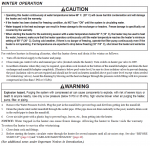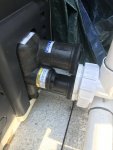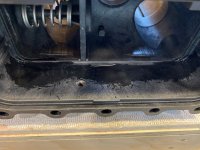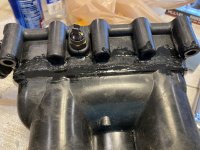So my question remains. Other than low ph levels is there any other reason I would want to install the bypass system? Would it prolong the life of my heater or reduce the pump's workload (enough to make a prolonged difference) because of the internal bypass you are discussing? Thanks.
Cracked heater manifold
- Thread starter Rick T
- Start date
You are using an out of date browser. It may not display this or other websites correctly.
You should upgrade or use an alternative browser.
You should upgrade or use an alternative browser.
What is the maximum flow rate that you will have?So my question remains. Other than low ph levels is there any other reason I would want to install the bypass system? Would it prolong the life of my heater or reduce the pump's workload (enough to make a prolonged difference) because of the internal bypass you are discussing? Thanks.
- May 23, 2015
- 25,799
- Pool Size
- 16000
- Surface
- Plaster
- Chlorine
- Salt Water Generator
- SWG Type
- Pentair Intellichlor IC-60
Mixing is only regulated when the heater is heating water. There are two spring forces and two flow paths involved. The other spring is on the bypass valve and it takes a good amount of force by hand to push it open (I have a spare). I suspect the forces are balanced such that when the water is flowing to the heater manifold the combination of the spring holding a closed thermal regulator in place is enough to force the bypass valve open. Then, when the thermal regulator opens, the bypass partially closes and most of water flows through the heat exchanger and out through the thermal regulator. With no heat applied, I suspect the flow through the heat exchanger is a tiny trickle at best.
In the pictures, the thermal regulator looks mostly closed. It is held in place by a spring, so it probably lets some water pass by pushing the regulator open some.
The purpose of the regulator is to reduce condensation buildup in the combustion chamber.
Pentair Thermal Regulator (38000-0007s) - INYOPools.com
"Your Source for Swimming Pool & Spa Parts With 40,000 Parts in Stock - INYOpools.com"www.inyopools.com
I‘m wondering if there are small paths within the manifold. Trapping air or stale water seems extreme. If it was sealed, one would think removing the thermostat/ regulator would be part of the winterizing process.
nice pictures and video. Perhaps one of the internals of the manifold exists.
cd
Perhaps one of the internals of the manifold exists.

Pentair Mastertemp Heater Water System Parts - INYOPools.com
Pentair Mastertemp Heater Water System - INYOpools.com has the largest selection of swimming pool and spa replacement parts with over 70,000 parts in stock. Order today and save!
Axemaster24!
New member
with all this being said, what is the procedure for protecting the heater during a freeze? I was taught by a YouTube video and one random pool repairman, at a store, to pull the black plug outside and let the water drain. If this isn’t enough to protect then what is?
- Jul 21, 2013
- 67,098
- Pool Size
- 35000
- Surface
- Plaster
- Chlorine
- Salt Water Generator
- SWG Type
- Pentair Intellichlor IC-60
with all this being said, what is the procedure for protecting the heater during a freeze? I was taught by a YouTube video and one random pool repairman, at a store, to pull the black plug outside and let the water drain. If this isn’t enough to protect then what is?
You asking about a Pentair MasterTemp heater?
See 3 & 4 below.


Pentair Mastertemp Heater Water System Parts - INYOPools.com
Pentair Mastertemp Heater Water System - INYOpools.com has the largest selection of swimming pool and spa replacement parts with over 70,000 parts in stock. Order today and save!www.inyopools.com
excellent, if I’m seeing correctly,
The left side of the rear section of the manifold has weep holes that drain to the front with one weep hole directly in back of the drain plug.


I did not see much for right side of the rear section of the manifold. Suspect it will drain to left side.
not sure why they recommend removing the pressure switch other than allowing air to enter the chamber quickly.
cd
with all this being said, what is the procedure for protecting the heater during a freeze? I was taught by a YouTube video and one random pool repairman, at a store, to pull the black plug outside and let the water drain. If this isn’t enough to protect then what is?
the manual is not so clear. Looking at the above pictures, my opinion is removing the 2” couplings and the drain plug is sufficient for emergencies like in Texas a week or so ago.
One reason the black drain plug might not be sufficient is in an emergency loss of power and air temp below freezing, the small orifice might be clogged with a thin layer of ice and keep the manifold from draining. I’ve seen this happen on pool pumps. When this happens, I have placed a small screwdriver in hot water the gently touch the opening. It normally immediately melts the ice and draining occurs. With an expensive heater, removing the 2” pipes allows air to enter and drain quickly.
this is only my opinion
like:

Last edited:
I think that just removing the drain plug should be sufficient.
It's probably a good idea to crack open the unions just to make sure that all water is drained and them resecure the unions once you have verified that there is no trapped water.
It's probably a good idea to crack open the unions just to make sure that all water is drained and them resecure the unions once you have verified that there is no trapped water.
Axemaster24!
New member
the manual is not so clear. Looking at the above pictures, my opinion is removing the 2” couplings and the drain plug is sufficient for emergencies like in Texas a week or so ago.
One reason the black drain plug might not be sufficient is in an emergency loss of power and air temp below freezing, the small orifice might be clogged with a thin layer of ice and keep the manifold from draining. I’ve seen this happen on pool pumps. When this happens, I have placed a small screwdriver in hot water the gently touch the opening. It normally immediately melts the ice and draining occurs. With an expensive heater, removing the 2” pipes allows air to enter and drain quickly.
this is only my opinion
like:
View attachment 177481
Thank you for the clarification, being I’m in the Houston area and this does have me a little worried about another freeze(with no power). I’ll pop the 2” fittings off the inlet & outlet Along with the drain plug. I refuse to suffer through another episode like we had.
mjfrederick
New member
I found myself in the same predicament as the original poster. Freeze cracked the manifold and the part is on backorder. I finally gave up and decided to try and repair the manifold. I drilled a very small hole at each end of the crack line and gouged out a small channel along the crack on both the inside and outside. I then filled the inside channel with resin, and filled the outside channel with resin and reinforced with fiberglass cloth. Just installed and tested. No leak, and heater is working!



richlscott
New member
Did you guys ever find a manifold. I too had the same issue, and I continue to look for one.
ppaull
New member
Hey Guys, just a hint if you're still looking for a manifold. I got one off of ebay for a 200K rated heater. I swapped out the back plate of my broken manifold and hooked it back in and it works fine! You might have to also swap out your thermal regulator but other than that the manifold housing are exactly the same!
Last edited by a moderator:
Thread Status
Hello , This thread has been inactive for over 60 days. New postings here are unlikely to be seen or responded to by other members. For better visibility, consider Starting A New Thread.


